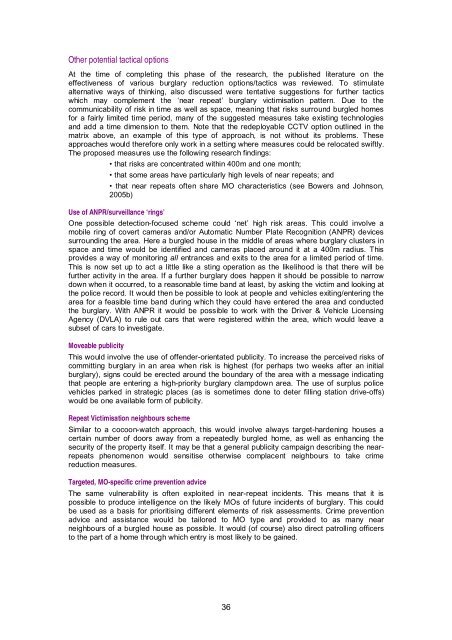Prospective crime mapping in operational context Final report
Prospective crime mapping in operational context Final report
Prospective crime mapping in operational context Final report
- No tags were found...
Create successful ePaper yourself
Turn your PDF publications into a flip-book with our unique Google optimized e-Paper software.
Other potential tactical optionsAt the time of complet<strong>in</strong>g this phase of the research, the published literature on theeffectiveness of various burglary reduction options/tactics was reviewed. To stimulatealternative ways of th<strong>in</strong>k<strong>in</strong>g, also discussed were tentative suggestions for further tacticswhich may complement the ‘near repeat’ burglary victimisation pattern. Due to thecommunicability of risk <strong>in</strong> time as well as space, mean<strong>in</strong>g that risks surround burgled homesfor a fairly limited time period, many of the suggested measures take exist<strong>in</strong>g technologiesand add a time dimension to them. Note that the redeployable CCTV option outl<strong>in</strong>ed <strong>in</strong> thematrix above, an example of this type of approach, is not without its problems. Theseapproaches would therefore only work <strong>in</strong> a sett<strong>in</strong>g where measures could be relocated swiftly.The proposed measures use the follow<strong>in</strong>g research f<strong>in</strong>d<strong>in</strong>gs:• that risks are concentrated with<strong>in</strong> 400m and one month;• that some areas have particularly high levels of near repeats; and• that near repeats often share MO characteristics (see Bowers and Johnson,2005b)Use of ANPR/surveillance ‘r<strong>in</strong>gs’One possible detection-focused scheme could ‘net’ high risk areas. This could <strong>in</strong>volve amobile r<strong>in</strong>g of covert cameras and/or Automatic Number Plate Recognition (ANPR) devicessurround<strong>in</strong>g the area. Here a burgled house <strong>in</strong> the middle of areas where burglary clusters <strong>in</strong>space and time would be identified and cameras placed around it at a 400m radius. Thisprovides a way of monitor<strong>in</strong>g all entrances and exits to the area for a limited period of time.This is now set up to act a little like a st<strong>in</strong>g operation as the likelihood is that there will befurther activity <strong>in</strong> the area. If a further burglary does happen it should be possible to narrowdown when it occurred, to a reasonable time band at least, by ask<strong>in</strong>g the victim and look<strong>in</strong>g atthe police record. It would then be possible to look at people and vehicles exit<strong>in</strong>g/enter<strong>in</strong>g thearea for a feasible time band dur<strong>in</strong>g which they could have entered the area and conductedthe burglary. With ANPR it would be possible to work with the Driver & Vehicle Licens<strong>in</strong>gAgency (DVLA) to rule out cars that were registered with<strong>in</strong> the area, which would leave asubset of cars to <strong>in</strong>vestigate.Moveable publicityThis would <strong>in</strong>volve the use of offender-orientated publicity. To <strong>in</strong>crease the perceived risks ofcommitt<strong>in</strong>g burglary <strong>in</strong> an area when risk is highest (for perhaps two weeks after an <strong>in</strong>itialburglary), signs could be erected around the boundary of the area with a message <strong>in</strong>dicat<strong>in</strong>gthat people are enter<strong>in</strong>g a high-priority burglary clampdown area. The use of surplus policevehicles parked <strong>in</strong> strategic places (as is sometimes done to deter fill<strong>in</strong>g station drive-offs)would be one available form of publicity.Repeat Victimisation neighbours schemeSimilar to a cocoon-watch approach, this would <strong>in</strong>volve always target-harden<strong>in</strong>g houses acerta<strong>in</strong> number of doors away from a repeatedly burgled home, as well as enhanc<strong>in</strong>g thesecurity of the property itself. It may be that a general publicity campaign describ<strong>in</strong>g the nearrepeatsphenomenon would sensitise otherwise complacent neighbours to take <strong>crime</strong>reduction measures.Targeted, MO-specific <strong>crime</strong> prevention adviceThe same vulnerability is often exploited <strong>in</strong> near-repeat <strong>in</strong>cidents. This means that it ispossible to produce <strong>in</strong>telligence on the likely MOs of future <strong>in</strong>cidents of burglary. This couldbe used as a basis for prioritis<strong>in</strong>g different elements of risk assessments. Crime preventionadvice and assistance would be tailored to MO type and provided to as many nearneighbours of a burgled house as possible. It would (of course) also direct patroll<strong>in</strong>g officersto the part of a home through which entry is most likely to be ga<strong>in</strong>ed.36
















